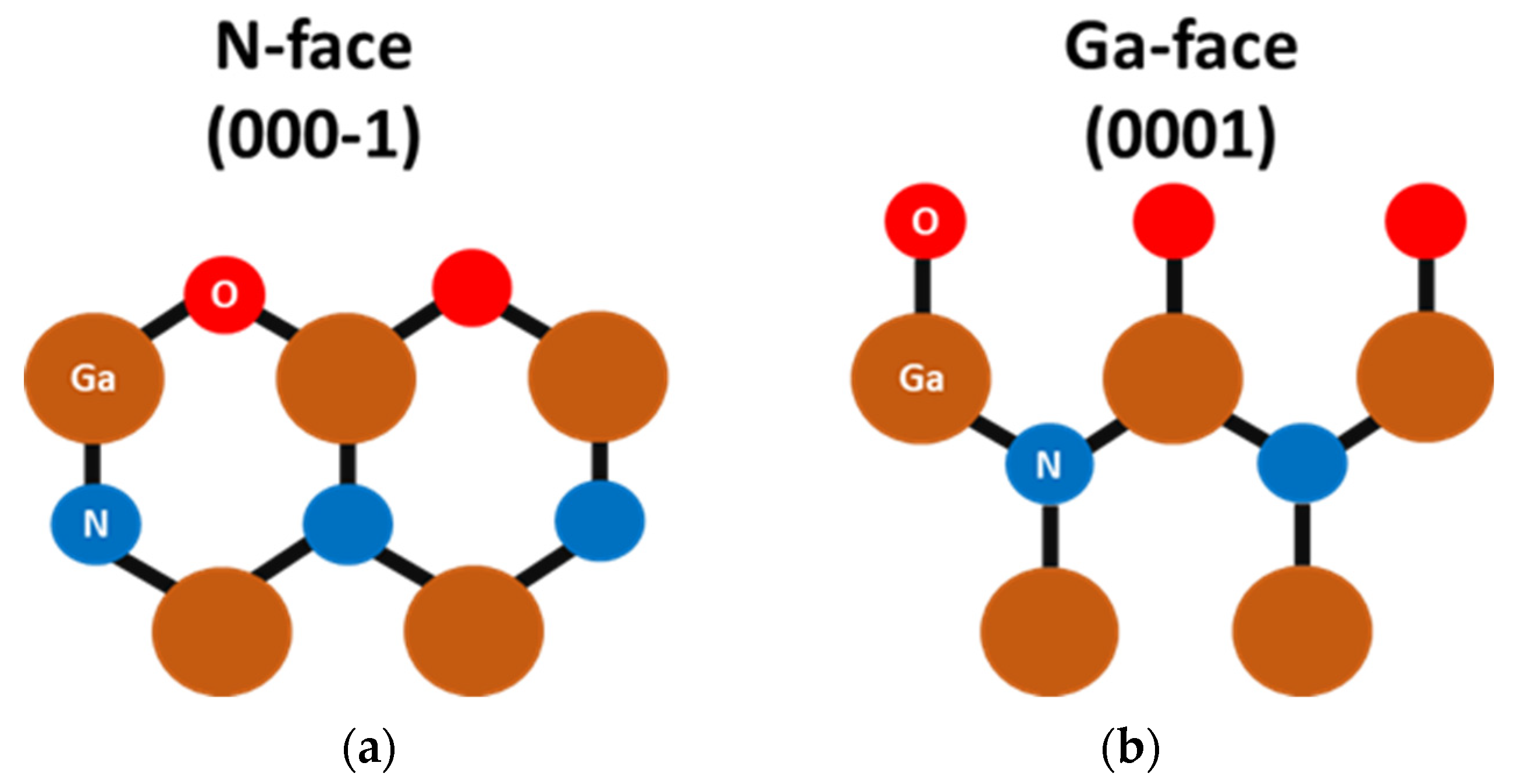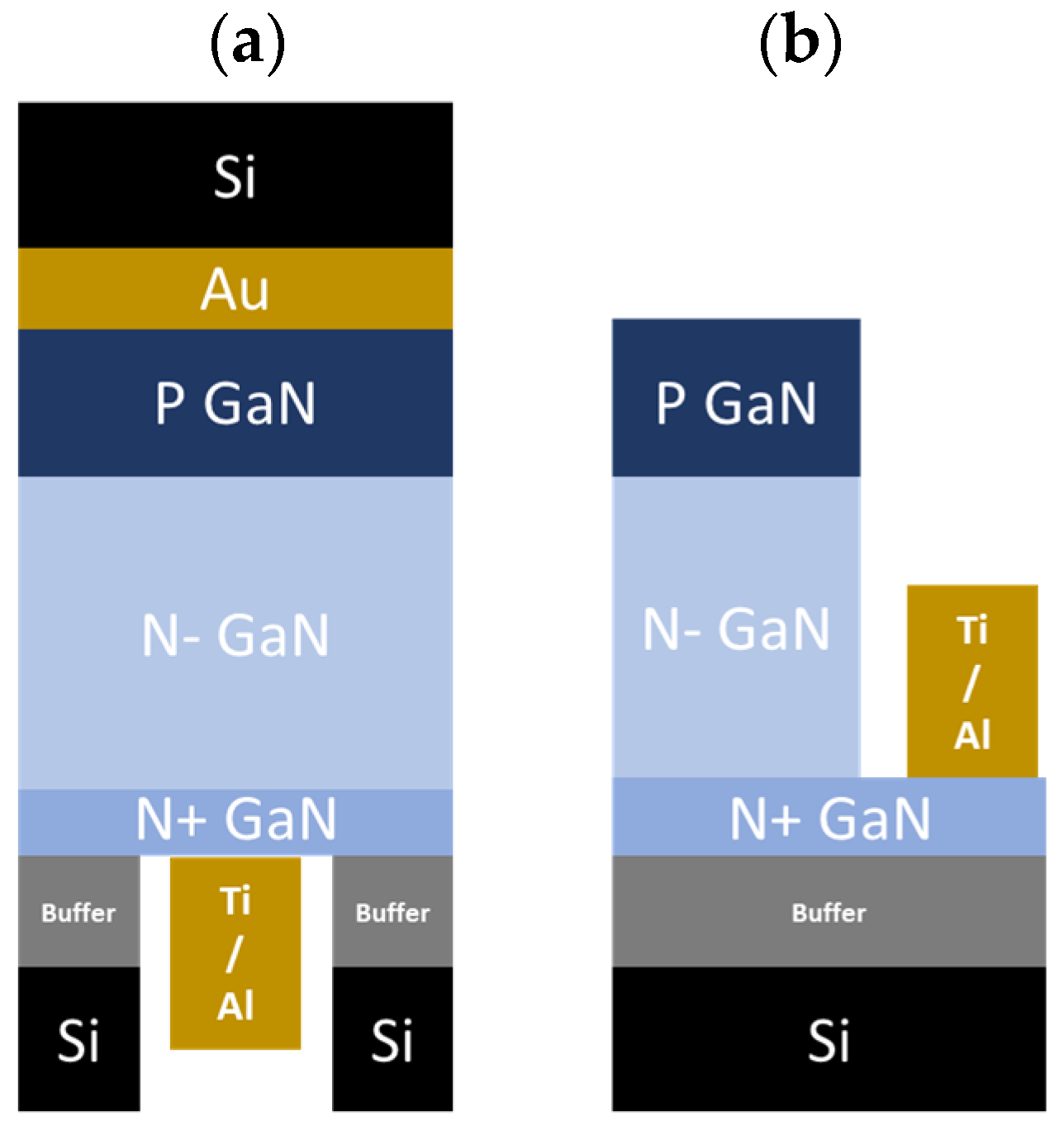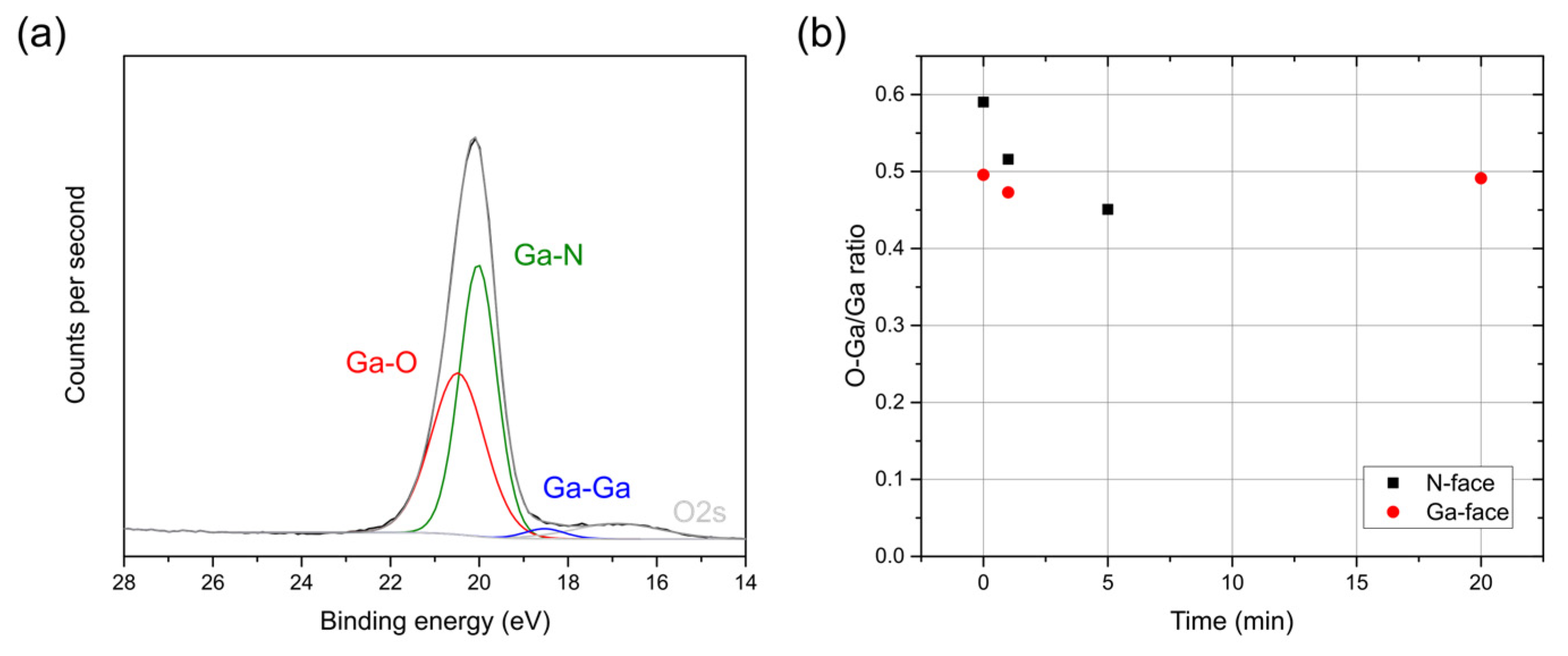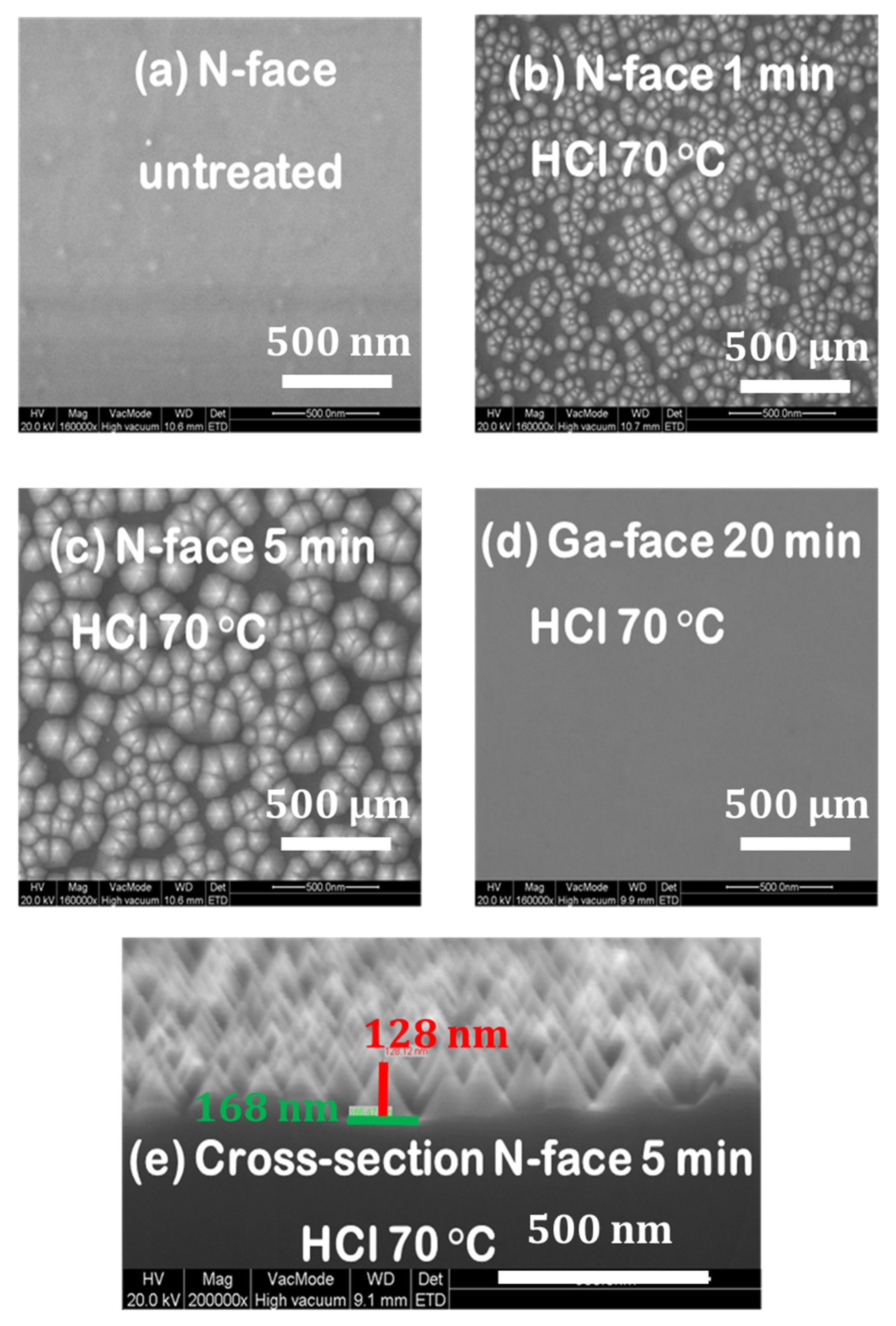Optimization of Non-Alloyed Backside Ohmic Contacts to N-Face GaN for Fully Vertical GaN-on-Silicon-Based Power Devices
Abstract
:1. Introduction
2. Device Fabrication and Characterization
- Control samples B1 and B2 were metalized without any treatment, with a delay of 10 min and 24 h after buffer etching, respectively.
- To investigate the time dependence, samples C1, C2, C3, and C4 were treated with HCl (37%) at 70 °C for 1 min, 2 min, 3 min, and 5 min prior to metallization, respectively.
- To investigate the temperature dependence, samples D1, D2, and D3 were treated with HCl (37%) for 1 min at room temperature, 55 °C, and 70 °C prior to metallization, respectively.
- An additional sample, referred to as sample A, was prepared with a pseudo-vertical structure. This configuration involved contacting the n+ layer from the front side on the Ga-face after ICP mesa etching (Figure 2b) to compare the Ti/Al ohmic contact quality with the N-face from the same GaN layer.
3. Results
4. Conclusions
Author Contributions
Funding
Data Availability Statement
Conflicts of Interest
References
- Abid, I.; Canato, E.; Meneghini, M.; Meneghesso, G.; Cheng, K.; Medjdoub, F. GaN-on-Silicon Transistors with Reduced Current Collapse and Improved Blocking Voltage by Means of Local Substrate Removal. Appl. Phys. Express 2021, 14, 036501. [Google Scholar] [CrossRef]
- Mishra, U.K.; Parikh, P.; Wu, Y.-F. AlGaN/GaN HEMTs-an Overview of Device Operation and Applications. Proc. IEEE 2002, 90, 1022–1031. [Google Scholar] [CrossRef]
- Hamdaoui, Y.; Abid, I.; Michler, S.; Ziouche, K.; Medjdoub, F. Demonstration of Avalanche Capability in 800 V Vertical GaN-on-Silicon Diodes. Appl. Phys. Express 2023, 17, 016503. [Google Scholar] [CrossRef]
- Brusaterra, E.; Bahat Treidel, E.; Brunner, F.; Wolf, M.; Thies, A.; Würfl, J.; Hilt, O. Optimization of Vertical GaN Drift Region Layers for Avalanche and Punch-Through Pn-Diodes. IEEE Electron Device Lett. 2023, 44, 388–391. [Google Scholar] [CrossRef]
- Abdul Khadar, R.; Liu, C.; Zhang, L.; Xiang, P.; Cheng, K.; Matioli, E. 820-V GaN-on-Si Quasi-Vertical p-i-n Diodes with BFOM of 2.0 GW/cm2. IEEE Electron Device Lett. 2018, 39, 401–404. [Google Scholar] [CrossRef]
- Guo, X.; Zhong, Y.; Zhou, Y.; Chen, X.; Yan, S.; Liu, J.; Sun, X.; Sun, Q.; Yang, H. 1200-V GaN-on-Si Quasi-Vertical p-n Diodes. IEEE Electron Device Lett. 2022, 43, 2057–2060. [Google Scholar] [CrossRef]
- Jia, F.; Ma, X.; Yang, L.; Zhang, X.; Hou, B.; Zhang, M.; Wu, M.; Niu, X.; Du, J.; Liu, S.; et al. 930V and Low-Leakage Current GaN-on-Si Quasi-Vertical PiN Diode with Beveled-Sidewall Treated by Self-Aligned Fluorine Plasma. IEEE Electron Device Lett. 2022, 43, 1400–1403. [Google Scholar] [CrossRef]
- Harrison, S.E.; Shao, Q.; Frye, C.D.; Voss, L.F.; Nikolic, R.J. 1.1 kV Vertical p-i-n GaN-on-Sapphire Diodes. In Proceedings of the 2018 76th Device Research Conference (DRC), Santa Barbara, CA, USA, 24–27 June 2018; pp. 1–2. [Google Scholar]
- Aktas, O.; Kizilyalli, I.C. Avalanche Capability of Vertical GaN P-n Junctions on Bulk GaN Substrates. IEEE Electron Device Lett. 2015, 36, 890–892. [Google Scholar] [CrossRef]
- Fu, K.; He, Z.; Yang, C.; Zhou, J.; Fu, H.; Zhao, Y. GaN-on-GaN p-i-n Diodes with Avalanche Capability Enabled by Eliminating Surface Leakage with Hydrogen Plasma Treatment. Appl. Phys. Lett. 2022, 121, 092103. [Google Scholar] [CrossRef]
- Zhang, Y.; Dadgar, A.; Palacios, T. Gallium Nitride Vertical Power Devices on Foreign Substrates: A Review and Outlook. J. Phys. D Appl. Phys. 2018, 51, 273001. [Google Scholar] [CrossRef]
- Qi, W.; Zhou, F.; Ma, T.; Xu, W.; Zhou, D.; Ren, F.; Chen, D.; Zhang, R.; Zheng, Y.; Lu, H. 0.58 mΩ⋅cm2/523 V GaN Vertical Schottky Barrier Diode with 15.6 kA/cm2 Surge Current Enabled by Laser Lift-Off/Annealing and N-Ion Implantation. IEEE Electron Device Lett. 2024, 45, 964–967. [Google Scholar] [CrossRef]
- Zhang, Y.; Yuan, M.; Chowdhury, N.; Cheng, K.; Palacios, T. 720-V/0.35-mΩ·cm2 Fully Vertical GaN-on-Si Power Diodes by Selective Removal of Si Substrates and Buffer Layers. IEEE Electron Device Lett. 2018, 39, 715–718. [Google Scholar] [CrossRef]
- Zywietz, T.K.; Neugebauer, J.; Scheffler, M. The Adsorption of Oxygen at GaN Surfaces. Appl. Phys. Lett. 1999, 74, 1695–1697. [Google Scholar] [CrossRef]
- Chung, R.B.; Chen, H.-T.; Pan, C.-C.; Ha, J.-S.; DenBaars, S.P.; Nakamura, S. The Polarization Field Dependence of Ti/Al Based Ohmic Contacts on N-Type Semipolar GaN. Appl. Phys. Lett. 2012, 100, 091104. [Google Scholar] [CrossRef]
- Jang, T.; Lee, S.N.; Nam, O.H.; Park, Y. Investigation of Pd/Ti/Al and Ti/Al Ohmic Contact Materials on Ga-Face and N-Face Surfaces of n-Type GaN. Appl. Phys. Lett. 2006, 88, 193505. [Google Scholar] [CrossRef]
- Young Moon, S.; Ho Son, J.; Jin Choi, K.; Lee, J.-L.; Jang, H.W. Indium as an Efficient Ohmic Contact to N-Face n-GaN of GaN-Based Vertical Light-Emitting Diodes. Appl. Phys. Lett. 2011, 99, 202106. [Google Scholar] [CrossRef]
- Seo, H.; Cha, Y.-J.; Islam, A.B.M.H.; Kwak, J.S. Improvement of Ti/Al Ohmic Contacts on N-Face n-Type GaN by Using O2 Plasma Treatment. Appl. Surf. Sci. 2020, 510, 145180. [Google Scholar] [CrossRef]
- Motayed, A.; Jah, M.; Sharma, A.; Anderson, W.T.; Litton, C.W.; Mohammad, S.N. Two-Step Surface Treatment Technique: Realization of Nonalloyed Low-Resistance Ti/Al/Ti/Au Ohmic Contact to n-GaN. J. Vac. Sci. Technol. B Microelectron. Nanometer Struct. Process. Meas. Phenom. 2004, 22, 663–667. [Google Scholar] [CrossRef]
- Redaelli, L.; Muhin, A.; Einfeldt, S.; Wolter, P.; Weixelbaum, L.; Kneissl, M. Ohmic Contacts on N-Face n-Type GaN after Low Temperature Annealing. IEEE Photon. Technol. Lett. 2013, 25, 1278–1281. [Google Scholar] [CrossRef]
- Zhou, R.; Feng, M.; Wang, J.; Zhong, Y.; Sun, Q.; Liu, J.; Huang, Y.; Zhou, Y.; Gao, H.; Ikeda, M.; et al. Effect of Surface Stoichiometry on the Non-Alloyed Ohmic Contact to N-Face n-GaN. Solid-State Electron. 2020, 171, 107863. [Google Scholar] [CrossRef]
- Fogarassy, Z.; Wójcicka, A.; Cora, I.; Rácz, A.S.; Grzanka, S.; Dodony, E.; Perlin, P.; Borysiewicz, M.A. Structural and Electrical Investigation of Al/Ti/TiN/Au Based N-Face n-GaN Contact Stack. Mater. Sci. Semicond. Process. 2024, 175, 108250. [Google Scholar] [CrossRef]
- Khachariya, D.; Szymanski, D.; Sengupta, R.; Reddy, P.; Kohn, E.; Sitar, Z.; Collazo, R.; Pavlidis, S. Chemical Treatment Effects on Schottky Contacts to Metalorganic Chemical Vapor Deposited N-Type N-Polar GaN. J. Appl. Phys. 2020, 128, 064501. [Google Scholar] [CrossRef]
- Grover, S.; Sahu, S.; Zhang, P.; Davis, K.O.; Kurinec, S.K. Standardization of Specific Contact Resistivity Measurements Using Transmission Line Model (TLM). In Proceedings of the 2020 IEEE 33rd International Conference on Microelectronic Test Structures (ICMTS), Edinburgh, UK, 4–18 May 2020; pp. 1–6. [Google Scholar]
- Reeves, G.K.; Harrison, H.B. Obtaining the Specific Contact Resistance from Transmission Line Model Measurements. IEEE Electron Device Lett. 1982, 3, 111–113. [Google Scholar] [CrossRef]
- Grodzicki, M.; Rousset, J.-G.; Ciechanowicz, P.; Piskorska-Hommel, E.; Hommel, D. XPS Studies on the Role of Arsenic Incorporated into GaN. Vacuum 2019, 167, 73–76. [Google Scholar] [CrossRef]
- Li, D.; Sumiya, M.; Fuke, S.; Yang, D.; Que, D.; Suzuki, Y.; Fukuda, Y. Selective Etching of GaN Polar Surface in Potassium Hydroxide Solution Studied by X-ray Photoelectron Spectroscopy. J. Appl. Phys. 2001, 90, 4219–4223. [Google Scholar] [CrossRef]
- Prabhakaran, K.; Andersson, T.G.; Nozawa, K. Nature of Native Oxide on GaN Surface and Its Reaction with Al. Appl. Phys. Lett. 1996, 69, 3212–3214. [Google Scholar] [CrossRef]
- Kushvaha, S.S.; Kumar, M.S.; Shukla, A.K.; Yadav, B.S.; Singh, D.K.; Jewariya, M.; Ragam, S.R.; Maurya, K.K. Structural, Optical and Electronic Properties of Homoepitaxial GaN Nanowalls Grown on GaN Template by Laser Molecular Beam Epitaxy. RSC Adv. 2015, 5, 87818–87830. [Google Scholar] [CrossRef]
- Choi, B.S.; Um, J.H.; Eom, H.J.; Jeon, D.-W.; Hwang, S.; Kim, J.K.; Yun, Y.H.; Cho, H. Wet etching of α-Ga2O3 epitaxy film using a HCl-based solution. J. Korean Cryst. Growth Cryst. Technol. 2022, 32, 40–44. [Google Scholar] [CrossRef]
- Jang, J.-S.; Park, S.-J.; Seong, T.-Y. Effects of Surface Treatment on the Electrical Properties of Ohmic Contacts to (In)GaN for High Performance Optical Devices. Phys. Stat. Sol. (A) 2002, 194, 576–582. [Google Scholar] [CrossRef]
- Ng, H.M.; Weimann, N.G.; Chowdhury, A. GaN Nanotip Pyramids Formed by Anisotropic Etching. J. Appl. Phys. 2003, 94, 650–653. [Google Scholar] [CrossRef]
- Jung, Y.; Ahn, J.; Baik, K.H.; Kim, D.; Pearton, S.J.; Ren, F.; Kim, J. Chemical Etch Characteristics of N-Face and Ga-Face GaN by Phosphoric Acid and Potassium Hydroxide Solutions. J. Electrochem. Soc. 2011, 159, H117–H120. [Google Scholar] [CrossRef]
- Han, S.-C.; Kim, J.-K.; Kim, J.Y.; Kim, K.-K.; Tampo, H.; Niki, S.; Lee, J.-M. Formation of Hexagonal Pyramids and Pits on V-/VI-Polar and III-/II-Polar GaN/ZnO Surfaces by Wet Etching. J. Electrochem. Soc. 2010, 157, D60. [Google Scholar] [CrossRef]










| Sample | Polarity | Treatment | Specific Contact Resistance (Ω·cm2) |
|---|---|---|---|
| A1 | Ga face | No treatment | 10−4 |
| A2 | Ga face | No treatment | 10−4 |
| B1 (no delay) | N face | No treatment | 2.4 × 10−4 |
| B2 (24 H delay) | N face | N treatment | High |
| C1 | N face | 1 min 70 °C of HCL | 7–8 × 10−5 |
| C2 | N face | 2 min 70 °C of HCL | 3.3 × 10−6 |
| C3 | N face | 3 min 70 °C of HCL | 9 × 10−6 |
| C4 | N face | 5 min 70 °C of HCL | High |
| D1 | N face | 1 min RT of HCL | High |
| D2 | N face | 1 min 55 °C of HCL | High |
Disclaimer/Publisher’s Note: The statements, opinions and data contained in all publications are solely those of the individual author(s) and contributor(s) and not of MDPI and/or the editor(s). MDPI and/or the editor(s) disclaim responsibility for any injury to people or property resulting from any ideas, methods, instructions or products referred to in the content. |
© 2024 by the authors. Licensee MDPI, Basel, Switzerland. This article is an open access article distributed under the terms and conditions of the Creative Commons Attribution (CC BY) license (https://creativecommons.org/licenses/by/4.0/).
Share and Cite
Hamdaoui, Y.; Vandenbroucke, S.S.T.; Michler, S.; Ziouche, K.; Minjauw, M.M.; Detavernier, C.; Medjdoub, F. Optimization of Non-Alloyed Backside Ohmic Contacts to N-Face GaN for Fully Vertical GaN-on-Silicon-Based Power Devices. Micromachines 2024, 15, 1157. https://doi.org/10.3390/mi15091157
Hamdaoui Y, Vandenbroucke SST, Michler S, Ziouche K, Minjauw MM, Detavernier C, Medjdoub F. Optimization of Non-Alloyed Backside Ohmic Contacts to N-Face GaN for Fully Vertical GaN-on-Silicon-Based Power Devices. Micromachines. 2024; 15(9):1157. https://doi.org/10.3390/mi15091157
Chicago/Turabian StyleHamdaoui, Youssef, Sofie S. T. Vandenbroucke, Sondre Michler, Katir Ziouche, Matthias M. Minjauw, Christophe Detavernier, and Farid Medjdoub. 2024. "Optimization of Non-Alloyed Backside Ohmic Contacts to N-Face GaN for Fully Vertical GaN-on-Silicon-Based Power Devices" Micromachines 15, no. 9: 1157. https://doi.org/10.3390/mi15091157








